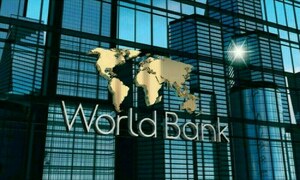World Bank Suggests Higher Taxes for Top Earners in Pakistan
The World Bank has advised Pakistan to implement higher effective tax rates for its highest-income groups. Furthermore, the existing income tax system could be made more progressive by eliminating exemptions for high-income earners and adjusting the highest tax rate’s income bracket.
According to the World Bank’s recent report, titled “South Asia Development Update, Taxing Times,” industrial production has decreased as a result of elevated input costs, increased taxation, and reduced government spending on development. The growth of services has also been negatively affected by the weak performance of agricultural and industrial sectors.
Among emerging market and developing countries (EMDEs), Pakistan exhibits one of the broadest ranges of tax rates and income thresholds across its personal income tax brackets, contributing to a relatively progressive income tax structure.
The government of Pakistan has pledged to increase tax revenues by 4–5% of GDP, reform the energy sector, and allow for a flexible exchange rate, as stated by the World Bank.
The report also points out that Pakistan’s guaranteed price for sugarcane and subsidies for water consumption encourage inefficient use of resources. These subsidies could be replaced with direct, targeted transfers, with larger amounts allocated to farmers who adopt sustainable land management techniques.
Pakistan’s tax buoyancy is among the lowest quartile of EMDEs, suggesting a heavy reliance on taxing slow-growing economic activities. Unlike Bhutan and Pakistan, other South Asian countries generate more tax revenue from consumption taxes (such as sales tax, excise taxes, and VAT) and trade taxes than the average EMDE, with a smaller proportion from income taxes. In 2024, Pakistan and Sri Lanka had consumption tax rates significantly higher than the EMDE average.
The report highlights that Pakistan, Sri Lanka, and Bangladesh, which have the lowest overall revenue-to-GDP ratios in South Asia, also have significantly lower tax revenue-to-GDP ratios compared to other EMDEs with similar tax rates across all tax categories.
Since 2020, Afghanistan, Bangladesh, Pakistan, and Sri Lanka have experienced substantial shortfalls in direct tax revenue, ranging from 1.4 to 2.6 percentage points of GDP, compared to an average shortfall of 0.8 percentage points among all EMDEs. These revenue shortfalls have been nearly evenly divided between personal and corporate income tax revenues in these four South Asian nations.
Country-specific characteristics account for one-quarter of the overall tax revenue shortfalls in Bangladesh and Bhutan and one-third in Pakistan and Sri Lanka. Widespread informality and a lack of financial development contribute significantly to the shortfall in personal income tax revenues in Bhutan, Pakistan, and Sri Lanka.
A large agricultural sector and a lack of financial advancement account for half of the corporate income tax revenue shortfall in Bangladesh, Pakistan, and Sri Lanka, as well as one-third of the consumption tax revenue shortfall in Pakistan and Sri Lanka. Even after accounting for these factors, these four nations still exhibit tax gaps that exceed the EMDE average.
The report identifies compliance risk management, timely tax declaration filings, tax dispute resolutions, tax payments, and monitoring inaccurate reporting as key areas for improvement in Pakistan’s tax system.
The introduction of electronic VAT filing and computerized risk analysis in Pakistan has halved refund claims and led to the detection of a significantly greater number of fraudulent claims than manual assessments.
The responsiveness of revenues to changes in tax bases in Bangladesh and India is comparable to other EMDEs. Nepal’s responsiveness is in the top quartile, while Pakistan’s is in the bottom quartile.
Tax buoyancies in Bangladesh and India are broadly aligned with those of other EMDEs, while Nepal’s ranks in the top quartile and Pakistan’s in the bottom quartile.
Below-average tax buoyancies, as seen in Pakistan, indicate that economic growth is disproportionately driven by under-taxed economic activities. In Pakistan, the agriculture sector contributed about one-fifth of cumulative growth during 2010–19, compared to less than one-tenth in the average EMDE. The agriculture sector in many parts of Pakistan faces significantly lower income tax rates than non-agriculture sectors, highlighting the need to increase taxation on agricultural activity.
The report further indicates that Pakistan’s economy is recovering from natural disasters, external pressures, and inflation, with an expected growth of 2.7% in fiscal year 2024-25 and 3.1% in fiscal year 2025-26.
Pakistan’s GDP grew by 2.5% in fiscal year 2023-24, following a slight contraction in fiscal year 2022-23. Strong remittance inflows supported private consumption, but private investment growth remained weak due to high real interest rates and political uncertainty. Agricultural growth reached a 19-year high due to favorable weather conditions, while industrial activity decreased, and services growth remained subdued. This weak growth has persisted into the first half of fiscal year 2024-25, with output increasing by an average of 1.5% year-on-year, slower than the 2.1% expansion in the first half of the previous year.
After a surge last year, agriculture experienced subdued growth in the first half of fiscal year 2024-25 due to drought-like conditions and pest infestations.
The government achieved a primary surplus in the first half of fiscal year 2024-25, with fiscal consolidation efforts supported by an IMF program. The current account was in surplus at the end of 2024, driven by higher remittances from reduced political uncertainty and exchange rate stability, which offset the wider trade and primary income deficits.
With reduced depreciation pressures on the currency, a robust agricultural harvest, and stable administrative prices, inflation steadily declined to 0.7% in March 2025 from nearly 40% in mid-2023. This allowed the central bank to lower its policy rate by 10 percentage points since June 2024, reaching 12% in January.



Comments (0)
No comments yet. Be the first to comment!
Leave a Comment